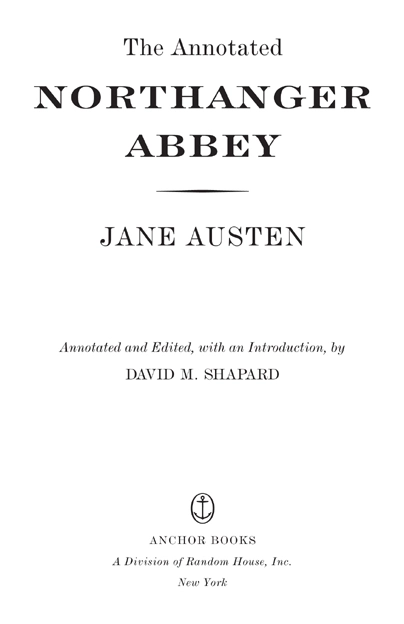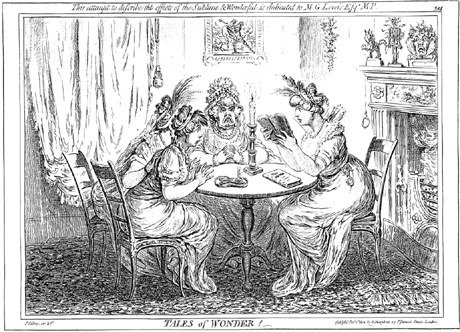The Annotated Northanger Abbey

AN ANCHOR BOOKS ORIGINAL, SEPTEMBER 2013
Copyright © 2013 by David M. Shapard
All rights reserved. Published in the United States by Anchor Books, a division of Random House LLC., New York, and in Canada by Random House of Canada Limited, Toronto, both Penguin Random House Companies.
Anchor Books and colophon are registered trademarks of Random House LLC.
eBook ISBN: 978-0-307-95026-0
Print ISBN: 978-0-307-39080-6
Library of Congress Cataloging-in-Publication Data
Austen, Jane, 1775–1817.
The annotated Northanger Abbey / by Jane Austen ; annotated and edited, with an introduction, by David M. Shapard. — First Anchor Books edition.
pages cm
Includes bibliographical references.
ISBN 978-0-307-39080-6 (pbk.)
1. Austen, Jane, 1775–1817. Northanger Abbey.
2. Young women—England—Fiction.
3. Horror tales—Appreciation—Fiction.
4. Gentry—England—Fiction.
5. Marriage—Economic aspects—Fiction.
6. England—Social life and customs—19th century—Fiction.
7. Satire.8. Gothic fiction.9. Love stories.
I. Shapard, David M. II. Title.
III. Title: Northanger Abbey.
PR4034.N7 2013
823.7—dc23
2013004497
Book design by Rebecca Aidlin
Maps by Robert Bull
Cover design: Megan Wilson
www.anchorbooks.com
v3.1

“Tales of Wonder!”: a contemporary satire on horror novel reading.
[From Works of James Gillray (London, 1849), Figure 514]
[List of Illustrations]
Annotations to the Front Cover

1. The house in this painting, called Oriel Lodge, was built in the early nineteenth century in Gothic Revival style, as indicated by, among other things, the pointed arches and heavy stone walls that were features of medieval Gothic buildings. Gothic Revival style began in the late eighteenth century and became increasingly popular; it reflected the same fascination with the Middle Ages that spurred the tremendous popularity of Gothic horror novels, which were usually set in actual medieval buildings. Catherine, the heroine of Northanger Abbey, is a devoted reader of these novels, and her naïve belief that the horrors they depict are a normal part of life lead her into a series of embarrassing delusions when she visits Northanger Abbey.
2. Villas such as Oriel Lodge were usually built in or near towns and, while elegant and highly adorned, were not as large as grand country houses such as Northanger Abbey (in this case, the picture shows most of the house’s front). Catherine’s friend Isabella at one point fantasizes about living in a villa near Richmond, a highly affluent suburb of London. Oriel Lodge is in Cheltenham, a popular spa town of the time; much of the novel is set in the even more popular spa town of Bath. Cheltenham also happens to be in Gloucestershire, the same county in which the fictional Northanger Abbey lies.
3. The turrets and castellated roof seen on this house were basic elements of medieval castles, created for practical purposes of defense, though here, as in other Gothic Revival buildings, they are purely decorative. They are also prominent features of an imitation medieval structure of the eighteenth century, Blaise Castle, that figures in an important episode in the novel. The prospect of visiting Blaise Castle, which Catherine is told is a genuine medieval edifice, tempts her into committing a serious breach of etiquette.
4. The windows of the house are heavily latticed. This was standard in medieval buildings, since the poor quality of glass at that time precluded larger panes, and Gothic Revival structures often imitate this feature. When she arrives at Northanger Abbey, Catherine is disappointed to discover that its windows, while still Gothic in their external outline, have been modernized, and thus that “every pane was so large, so clear.”
Contents

Cover
Title Page
Copyright
Annotations to the Front Cover
Illustrations
Notes to the Reader
Acknowledgments
Introduction
NORTHANGER ABBEY
Advertisement by the Authoress
VOLUME I
(Note: The following chapter headings are not found in the novel.
They are added here by the editor to assist the reader.)
I The History of Catherine Morland
II The First Ball at Bath
III Introduction to Henry Tilney
IV Introduction to the Thorpes
V The Friendship of Catherine and Isabella
VI The Discussion of Udolpho
VII The Arrival of John Thorpe and James
VIII Introduction to Eleanor Tilney
IX The Excursion with John Thorpe
X The Second Dance with Henry Tilney
XI The Broken Engagement with the Tilneys
XII Catherine’s Apology to the Tilneys
XIII Introduction to General Tilney
XIV The Walk with Henry and Eleanor
XV Isabella’s Engagement
VOLUME II
I Isabella’s Disappointment
II The Invitation to Northanger Abbey
III Isabella’s Flirtation with Captain Tilney
IV Henry on Isabella and Captain Tilney
V Catherine’s Journey to Northanger Abbey
VI Catherine’s Alarm About the Mysterious Paper
VII The Tour of the Gardens
VIII The Tour of the House
IX Catherine’s Folly Exposed
X Distressing News from James
XI The Visit to Henry’s House
XII Isabella’s Letter to Catherine
XIII The Expulsion from Northanger Abbey
XIV Catherine’s Return Home
XV Henry’s Visit to Catherine
XVI Conclusion
Notes
Chronology
Bibliography
Maps
About the Author
Other Books by This Author
Illustrations

The Pleasures of a Horror Novel
Two Girls
Playing Cricket
A Girl with a Bird
A Girl with a Bird
A Girl Sketching
A Woman with Curled Hair
A Lord
A Family with a Pianoforte
A Map of Bath
A Man with Gout
The Discomforts of Travel
A Mail Coach
The Bank of England
Pulteney Street
Highway Robbery
Women with High Feathers
Two Women Dancing
Tea Things
A Ball in the Upper Rooms
A Bath Chair
The Pump Room
Dancing at the Lower Rooms
An Introduction by the Master of Ceremonies
A Concert at Bath
A Clothing Store
A Pin for a Headdress
Women in Caps
The Pump Room
A Woman with a Pelisse
Women in Contemporary Costume
The Bath Theatre
A Bookstore
Frances (Fanny) Burney
Milsom Street
A Gothic Revival House
A Woman Leaving a Bookshop
The Exterior of the Pump Room
The Archway
A Busy Street Scene
A Gig
A Turning in the Road
A Curricle
A Coach
Women with Large Muffs
A Tippet
A Woman with a Tippet
A Map of the Upper Rooms
The Vestibule of the Upper Rooms
The Ballroom of the Upper Rooms
The Exterior of the Upper Rooms
Bath Architecture
A Woman with Jewelry in Her Hair
A Jewel for the Head
Women in Evening Dress
A Letter by Jane Austen
A Woman at Needlework
A Horse
The Main London Synagogue
A Man with Gout
Drinking at Oxford
Horse Racing
An Accident While Fox Hunting
A Spotted Muslin Gown
Women with Bonnets
Avoiding a Dance Partner
A Woman at an Embroidery Frame
A Fan
Fox Hunting
Fox Hunting
A Hunting Party
Selling a Horse
Dancing at Bath
Men’s Evening Dress
Dance Steps
A Sedan Chair
Women in Contemporary Fashion
Blaise Castle House
Kings Weston
Pulteney Bridge
A Ruined Castle
A Woman in a White Gown
Watching a Performance from a Box
Watching a Performance from a Box
The Bath Theatre
A Bath Theatre Playbill
A Bath Chair
The Royal Crescent
The Royal Crescent
Falling Down the Royal Crescent
A Crowded Outdoor Gathering
An Older Man
Portrait of a Woman
The Old Bridge
A Sampler
Two Samplers
The View from Beechen Cliff
A Picturesque Image
A Picturesque Image
A Picturesque Image
The Tower of London
The Gordon Riots
The Gordon Riots
The Bank of England
A Dragoon
A Pastry Shop
A Cottage
A Cottage
A Villa
A Villa near London
A Bath Interior
Milsom Street
A Bath Interior
A Chaise
A Man in Formal Dress
Women in Evening Dress
A Clergyman
Drinking the Waters at Bath
Milton Abbey
An Older House in a Low Position
The Exterior of the Pump Room
Two Women
The Pump Room—Interior
A Young Woman
A Man in Daytime Dress
A Woman in Daytime Dress
An Army Officer
A Posting Inn
Breakfast
A Chaise with Postilions
A Ladies’ Toilette
A Tapestry
A Chest
A Wardrobe
A Chapel in the Moonlight
Ruined Arches
A Lodge
A Woman with a Bonnet
An Older Fireplace
A Rumford Stove
A Marble Chimneypiece
A Fancy Staircase
Older Windows
A Chest
A Woman in a Muslin Dress
A Woman with Her Lady’s Maid
A Dining Room
A Drawing Room
A Fender
A Cabinet
A Japanned Chest of Drawers
A Bed
A Man with Powdered Hair
The London Wedgwood Shop
A Landscaped Ground
An Older House
A Forcing Garden
A Winding Path
A Portrait Painting
A Portrait Painter’s House
A Private Library
Billiards
Shooting Birds
A Partly Gothic House
A Maidservant Ironing
A Maidservant Washing
Pattens
A Carved Staircase
A Mother with a Child
An Interior Doorway
Ancient Tombs
A Bedroom
Painted Chairs
The College of Physicians
A Gloomy Castle
Oxford
Young Men at Oxford
A Drawing Room
A Deer Park
A Parsonage
A Parsonage
A Young Man Shooting
A Cottage
A House with a Sweep
A Newfoundland Dog
A Shop with Bow Windows
A Cottage amid Trees
A Side Table
Bath Street
Turbans
A Woman with a Turban
Two Women
Costume for Outdoors
An Older House
Salisbury Cathedral
Salisbury Cathedral
A Phaeton
Tea Tables
Children
Gloves
A Young Woman
A Mother with Children
An Older Man
A Marriage Ceremony
A Lord
Notes to the Reader

Literary interpretations: Comments on the techniques and themes of the novel, more than other types of entries, represent the personal views and interpretations of the editor. Such views have been carefully considered, but inevitably they will provoke disagreement among some readers. I can only hope that, even in those cases, the opinions expressed provide useful food for thought.
Differences of meaning: Many words in Jane Austen’s era, like many words now, had multiple meanings. The meaning of a word that is given at any particular place is intended to apply only to the way the word is used there; it does not represent a complete definition of the word in the language of the time.
1 comment